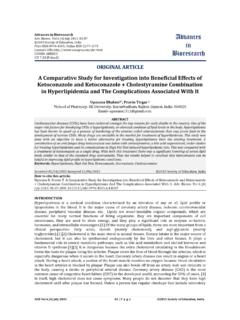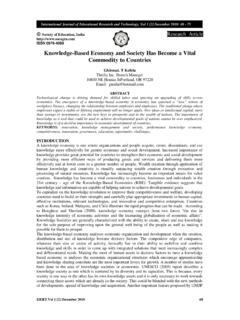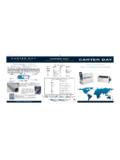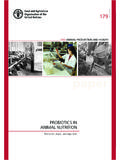Transcription of Advances CODEN: ABRDC3 Bioresearch
1 ABR Vol 6 [2] March 2015 108 | P a g e 2015 Society of Education, India Advances in Bioresearch Adv. Biores., Vol 6 (2) March 2015: 108-111 2015 Society of Education, India Print ISSN 0976-4585; Online ISSN 2277-1573 Journal s URL: CODEN: ABRDC3 ICV [Poland] OORRIIGGIINNAALL AARRTTIICCLLEE Effect of Dietary Protein on Carcass and Fleece traits of Iranian Markhoz goats Farzad Abdollahzadeh*1, Shoresh Yousefi2 1 Young Researchers and Elite Club, Boukan Branch, Islamic Azad University, Boukan, Iran 2 Young Researchers and Elites Club, Sanandaj Branch, Islamic Azad University, Sanandaj, Iran *Corresponding author: ABSTRACT The effect of dietary varying levels of crude protein on carcass traits and fleece characteristic of Markhoz (Iranian Angora) kid goats was studied.
2 Fifty four male kids were used in a completely randomized design with 3 3 factorial experiment and given different diets for 98 d. The results showed that, the effects of dietary different levels of CP were statistically significant (P< ). The higher supply of dietary protein resulted in heavier (P < ) slaughter BW, empty BW, hot carcass weight and higher (P < ) dressing percentage than lower dietary nutrient concentrations. Increasing dietary protein increased (P< ) fiber length and fiber diameter but had little effect on greasy fiber weight, fiber strength and fiber efficiency. In conclusion, it could be said that dietary nutrients concentration has a main role in increasing mohair fiber and particularly meat production by Markhoz kid goats.
3 Key words: Mohair fiber, Carcass traits, fleece characteristic. Received 11/12/2014 Accepted 03/02/2015 2015 Society of Education, India How to cite this article: Farzad A, Shoresh Y. Effect of Dietary Protein on Carcass and Fleece traits of Iranian Markhoz goats. Adv. Biores., Vol 6 [2] March 2015: 108-111. DOI: INTRODUCTION Markhoz goat (Iranian Angora) is the only single coat goat producing shiny fine fibers in Iran. Markhoz goat population in Iran is estimated at 25000 heads in 1996 [1]. The fleece taken from Markhoz goat is called mohair. Mohair production by Angora goats is an important livestock enterprise in some parts of the world [2].
4 The nutritional management of the animal can interfere on the mohair production and a poor quality diet will curtail mohair development. Mohair fiber is pure protein thus, Angora goats has a high protein requirement due to their rapid hair growth compared to other ruminant species. It has been shown that fiber production (wool or mohair) can be increased by as much as 20% through the use of rumen by-pass proteins. The kind or quality of protein consumed by ruminants, including the Angora goat, is not considered to be particularly important. Production efficiency would potentially be improved if a significant proportion of these feed proteins could get through the rumen without being degraded. This would be especially true with respect to mohair production if the protein feeds used were made up of high quality protein, rich in limiting amino acids such as methionine.
5 Some protein concentrates (fishmeal, blood meal, meat meal or feather meal) are poorly or slowly digestible and thus have some rumen escape properties. Fishmeal not only has escape value, but is also high in the sulfur containing amino acids and has been shown to be useful to increase fiber production. Because nutritional variation and especially quality of dietary protein is the most important environmental factor influencing mohair growth and carcass components of Angora goat [3] this experiment have been undertaken to assess the effects feeding different levels of By-pass protein (Fishmeal) on fleece characteristics and diet digestibility of Angora male kid goats. MATERIAL AND METHODS Animals and management AAddvvaanncceess iinn BBiioorreesseeaarrcchh ABR Vol 6 [2] March 2015 109 | P a g e 2015 Society of Education, India The current experiment was carried out at the Saqqez Animal Breeding Research Institute, during 2008 to 2009.
6 Twenty four male Markhoz goat kids aged 4 months, and weighing 3kg BW were selected for the feeding trial during 98 days (adaptation: 14 d and experimental period: 84 d). The animals were then allotted randomly to four treatments. At the beginning of the experiment, all goats were treated with an effective anathematic and vaccinated against enterotoxaemia. The kids were housed in individual metal-mesh cages ( m) and given ad libitum access to standard completely mixed diets (Table 1) throughout the study. Table 1: experimental diets differing in CP ratio fed in male goat kids Feeding treatments (diets) 1 2 3 4 item control 10% cp 12% cp 14% cp Alfalfa hay 40 36 34 Wheat straw 20 21 35 Barley grain 26 34 23 Cottonseed meal 6 14 Limestone 1 1 1 Salt Chemical compositions: CP (%DM) 15 10 12 14 NDF(%DM) ADF(%DM) 26 22 Ash (%DM) CP, crude protein; NDF, neutral detergent fiber; ADF, acid detergent fiber.
7 The animals also, had free access to drinking water, limestone and salt at all times. Animal pens were cleaned weekly and the kids weighed monthly on two consecutive days (before morning feeding) for monitoring body weight gain. All animals taken into this study received equal management and the kids maintained good health throughout the study. Feeds and experimental diets Four diets contained different levels of CP (8, 10 and 12 percent) were fed to experimental animals for 12 weeks. The diets were prepared according to the NRC, (1981) guidelines and offered as total mixed rations twice daily, at 7:00 and 16:00 h, to ensure 10% refusal each day (as-fed basis). Ingredients and chemical compositions of the diets are presented in Table 1.
8 Cottonseed meal and barley grain were used in diet as protein and energy supplements respectively. Data collection and laboratory analyses Daily feed intake was monitored on individual goats and any refusals were taken into account, weighed and sub sampled for later analysis. The diet and refusal sub samples were ground through a mm screen then analyzed for DM (using oven drying at 100 C), CP (N ), and ash (combustion at 550 C for 6 h) according to standard procedures AOAC, [5]. Neutral detergent fiber (NDF) and acid detergent fiber (ADF) was determined as described by Van Soest et al., (1991). At the end of the experimental period goats were shorn and greasy fleece weight was determined just after shearing.
9 A fleece sample (10-cm 10-cm areas) from the mid side was meticulously sheared and bagged separately in moisture proof- plastic bags and taken to the Wool Laboratory for length (Hauteur and Barbe length items) and diameter analysis. The sub samples were prepared for measurement with the projection microscope technique in accordance with ASTM, (5) short section procedure to determine fiber diameter, as well was paralleled in fibro liner component of Almeter 100 (Peyer Texlab FDA 200 Siegfried Peyer Ltd. Ch- 8832 Wollerau Switzerland), to determine the Simi rigid Hauteur and Barbe length. The staple strength of sub sampled fleece was determined using an Agritest Staple Breaker System (Agritest Pty, Sydney, Australia) as the maximum load (Newtons) needed to break a staple.
10 Carcass characteristics Abdollahzadeh and Yousefi ABR Vol 6 [2] March 2015 110 | P a g e 2015 Society of Education, India At the end of the feeding trial (14d adaptation and 84d experimental period), half of the animals (3 kids/each treatment) were withheld for water and feed after an overnight period and slaughtered (according to Farid, 1989 procedure) the next morning after weighing. The abdominal fat was removed and measured then warm carcass weighed immediately after dressing and removal of the offal parts. Over and above, subcutaneous fat thickness was measured by caliper. The carcasses were split sagittally, weighed and taken for cooling in a cold storage chamber (from 2 to 4 C) for 24 hours.













